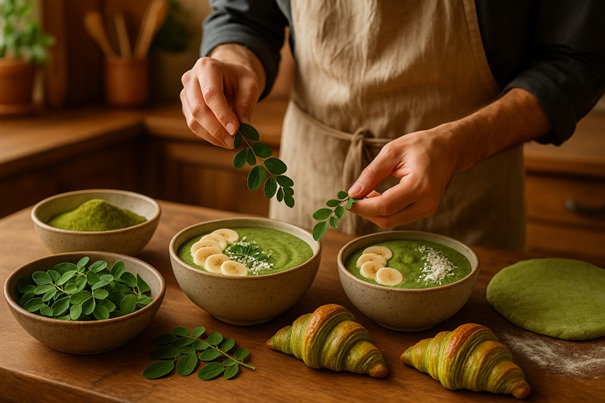Long overlooked in mainstream cuisine, Moringa oleifera — also known as the "drumstick tree" — is making a quiet but powerful comeback in global kitchens. Once confined to traditional medicine and rural diets across South Asia and Africa, this nutrient-dense plant is now emerging as a superfood staple in modern dishes, thanks to its versatility and impressive health profile.
From vegan restaurants in Berlin to nutrition startups in California, Moringa is showing up in smoothies, stews, seasoning powders — even chocolate.
So What's Special About Moringa?
Rich in vitamin A, iron, calcium, and protein, Moringa contains more nutrients per gram than kale, spinach, or even spirulina. Its leaves are edible both raw and cooked, and they maintain much of their nutritional content even when dried into powder.
A 2024 study by the Global Institute of Functional Foods found that incorporating just 10 grams of Moringa leaf powder daily improved iron levels in participants more effectively than traditional iron supplements.
"It's not just hype. Moringa is a complete food," says Elena Gutierrez, a botanical nutritionist from Barcelona. "It's one of the few plant sources that naturally provides all nine essential amino acids."
From Tree to Table: How It's Used Today
What sets Moringa apart isn't just its nutrition — it's its adaptability in cooking. Chefs are now integrating it into:
- Soups and broths, for a subtle earthy flavor.
- Homemade pasta and bread doughs, where it adds a vibrant green hue.
- Energy bars and protein shakes, as a plant-based enhancer.
- Even coffee blends, where it provides a caffeine-free antioxidant boost.
In Nairobi, for instance, urban cafés have begun serving Moringa-infused chapati, while a Lisbon bakery now offers a "green croissant" enriched with Moringa powder and almond butter.
Sustainability and Global Appeal
Beyond nutrition, Moringa is celebrated for its eco-resilience. The tree thrives in arid climates, requires minimal water, and grows rapidly — making it a promising crop for regions facing climate-induced food insecurity.
As more consumers seek climate-smart foods and plant-based options, Moringa's profile is rising among food tech investors and wellness entrepreneurs alike.
Is It the Next Quinoa or Something Bigger?
While foods like quinoa or acai have ridden waves of popularity, Moringa's entry feels different — less trendy, more purposeful.
Its affordability, sustainability, and cultural roots make it uniquely positioned to become a dietary staple rather than just a superfood trend.
"Adding Moringa to your cooking isn't about chasing the next fad," says Ana Ribeiro, a chef focused on regenerative cuisine. "It's about reconnecting with food that works for both our bodies and our planet."



